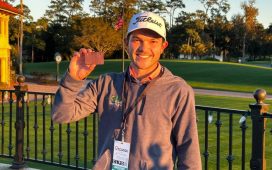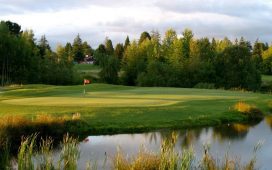Quaker Ridge Golf Club has long been considered a landmark.
Now it’s official.
When a major clubhouse renovation is completed in the coming months, plaques on either side of the main entrance will celebrate the club’s recent addition to the New York State and National Registers of Historic Places.
The course is listed at No. 7 on the Golfweek’s Best Private Courses in New York.
“Our membership is extraordinarily proud,” club president Jeff Shapiro said. “We are honored to join the ranks of great golf clubs in the country that have achieved this honor, including Winged Foot, Baltustrol, Shinnecock, Merion, Oakmont and Augusta National.”
That’s exclusive company.
“I’m not sure any of us knew you could apply to be on this list,” said Jeff Golenbock, a Quaker Ridge member since 1978 and the club’s vice president. “In order to be considered for this, you have to have a great golf course, but they were equally interested in how the club was formed, the clubhouse and what is now the caddie house, which at one point was an school attended by African American kids in Scarsdale. I didn’t even know that history until we started this process.”
There are numerous sites around Westchester that have earned recognition from the National Register of Historic Places.
Washington Irving’s Sunnyside in Tarrytown, St. Paul’s Church in Mount Vernon, Playland Park in Rye, the John Jay Homestead in Katonah, Van Cortlandt Manor in Croton, Kykuit in Pocantico Hills, the Elephant Hotel in Somers, Thomas Paine Cottage in New Rochelle and the Old Dutch Church in Sleepy Hollow are just a few of the other sites on the list.
Inclusion often comes with tax benefits or preservation assistance, but not in this case. The goal was earning a place alongside the clubs that have been longstanding stewards of the game.
“We couldn’t be happier,” said Martin Davis, a noted golf historian and member at Quaker Ridge for 38 years. “It’s really just nice to get the recognition we believe the club deserves. You mention Winged Foot to a golfer and they go, ‘Wow.’ ”
The clubs are situated across the street from each other.
“Quaker Ridge is in that same category,” added Davis, who’s been involved since Day 1 of the project along with general manager Bob Musich and former club president Marc Friedman. “We’ve always been very proud of the club and what we have and this kind of makes it official.”
The designation also provides a speed bump if the state proposes widening the Hutchinson River Parkway, which shares a boundary with the club.
“It does give them some protection against any federally-funded projects,” said Penny Watson, a principal at Watson & Henry, who helped Quaker Ridge and Winged Foot in New York and Baltusrol and Ridgewood Country Club in New Jersey navigate the application and review process. “It doesn’t mean it couldn’t happen, but there would have to be an impact statement and possibly mitigation if it did happen.”
It’s an early work of A.W. Tillinghast, a prolific architect who ranks among the pillars of the Golden Age. He is also responsible for Winged Foot East and West, Baltusrol Upper and Lower and Ridgewood.
Tillinghast was originally commissioned to redesign seven existing holes and build 11 new holes that opened for play in 1918. He was back a decade later after Quaker Ridge acquired more land and wanted to redesign the opening holes.
“Quaker Ridge was Tillinghast’s first great golf course,” Davis said. “The first important decision our first president, William Rice Hochster, and the board was hiring this up-and-coming architect from Philadelphia. The course you see today is exactly what Tillinghast left except for a little bit of length.”
Robert Trent Jones and Rees Jones were brought in over the years to make some modifications, but a sympathetic restoration by Gil Hanse that was completed in 2008 brought most of the original design elements back into play.
“From 80 yards in, the course is exactly how Tillinghast left it,” Davis said.
Quaker Ridge resisted changes a decade ago when a litigious neighbor along the second hole sued, complaining of constant golf ball incursions. A number of expensive modifications were made to a shared tree line before the club prevailed in a lengthy court battle.
The course is currently No. 39 on GOLF’S latest ranking of top 100 courses in the U.S.
Unlike many of the other courses on the national register, Quaker Ridge is rarely in the national spotlight. The others have hosted major championships.
“I’m not sure there was a lot of interest early on,” Davis said. “We don’t have the property needed to host these events. We’ve always had local tournaments. In 1936 we hosted the Met Open and that was Byron Nelson’s very first tournament victory. In those days, the Met Open was without question the fourth most important tournament in the country along with the U.S. Open, the PGA Championship and the Western Open.”
Quaker Ridge did host the Walker Cup in 1997 and the Curtis Cup in 2018.
The founding members were wealthy Jewish men of German descent whose applications for membership at other golf clubs were rejected. Their efforts to push back against patterns of anti-Semitism by matching elite Gentiles’ clubs in terms of excellence and status are recognized in the national register application.
Ely Jacques Kahn, the architect behind several Manhattan landmark buildings, was hired to design the simple Tudor clubhouse, which is currently under renovation.
“We took great pains to ensure it will look exactly like the old clubhouse,” Golenbock said. “It mimics the original design. Everything will look like it did in the 1920s in terms of the architecture, which kind of brings everything together.”
The caddie house, which sits near the main gate, also has a local history.
According to the application, it was built in 1901 and was known as the Scarsdale Free School District No. 2. The building was later expanded to include four classrooms. It operated as an integrated school through World War II and became property of the club after it was no longer needed.
Several members past and present began their educations in that space.
When the local population grew, Quaker Ridge sold the school back to Scarsdale in 1952 for $25,000 with the provision that ownership reverts to the club when it was no longer needed. That happened in 1959 after the Quaker Ridge School was built.
Mike Dougherty covers golf for The Journal News/lohud.com, part of the USA Today Network. He can be reached at mdougher@lohud.com, or on Twitter @hoopsmbd, @lohudlacrosse, @lohudhoopsmbd and @lohudgolf.








